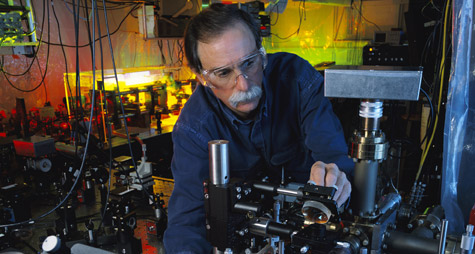David J. Wineland, the 2012 winner of the Nobel Prize in Physics, presented this year’s Anna McPherson Lectures on Nov. 6 and 7. In the lectures, he explained his research that won the Nobel Prize in Physics: The development of a laser cooling system that traps single ions and reduces their vibrational energy to a minimum.
“David Wineland and his research partner, Serge Haroche, won the most prestigious award in scientific research […] for inventing and developing methods for measuring and manipulating individual particles, while preserving their quantum-mechanical nature in ways that were previously thought unattainable,” explained Assistant Professor Lily Childress in her introduction for Wineland.
Wineland’s research involves observing specific quantum mechanical effects. To be able to understand his work however, one must first be familiar with quantum superposition and the Schrödinger’s Cat thought experiment.
Quantum superposition is a property of subatomic particles that dictates the condition of the state of existence of these particles. For example, when an atom is not being observed, it is neither in a ground state nor in any of its excited states, but rather it exists simultaneously in all of these states. When the atom is being observed, this simultaneous existence collapses into one state.
Superposition is difficult to understand for people who almost exclusively observe macroscopic events in their daily lives. In order to demonstrate how odd the principles of quantum mechanics would be, Erwin Schrödinger presented his famous thought experiment. Say there’s a cat in a closed box with some poison. If we apply the concept of superposition, there’s a 50 per cent chance that the poison has killed the cat, but there’s no way of knowing this definitely until the lid is opened. In this situation, using quantum mechanical terms, the cat is said to exist in a superposition state of being both dead and alive, until we choose to open the lid and observe what has happened. As we observe the inside of the box, the superposition state collapses into one of the two possible observable outcomes.
Wineland’s research focuses on isolating single ions known as individual quantum systems. Wineland and his colleagues discussed the idea of capturing a single particle in 1973, and since 1975 have been working on isolating a single ion—methods now termed ‘trapping techniques.’ Ion traps are created in an ultra-high vacuum using a combination of static and oscillating electric fields. The ions, using advanced lasers, are cooled down to close to absolute zero, where the ions exhibit a narrower range of quantum mechanical reactions to any change in the system, which makes analysis much easier. To do this, the lasers hit the ion and cause it to emit photons—packets of energy—of a higher average energy than the one it absorbed from the laser. Over time, the ions lose a significant amount of energy, bringing them closer and closer to absolute zero.
Wineland and Haroche’s team successfully developed a system that trapped single ions, cooled them to ground state, and observed the quantum mechanical effects of exciting the ion.
Quantum computers and atomic clocks
The use of singular atoms and ions is starting to be applied to quantum computing and atomic clocks—two of the most cutting-edge quantum technologies available today. Consequently, Wineland has successfully developed the most precise atomic clock in the world. Atomic clocks keep time by measuring the transitional frequency of an atom, which is the frequency of the radiation given off by the atom as it is excited or grounded. By isolating a caesium-133 atom in ground state, and measuring how many cycles a transitional vibration makes within a second, researchers have come up with a new definition for a second.
“These clocks are used extensively—ranging from GPS to synchronizing time globally—because they are the most precise and accurate clocks ever made, with a loss of [one] second [every] 20 million years,” Wineland explained.
Quantum computing currently does not actually involve any computation, but rather the analysis of single or multiple quantum systems. Atoms or ions trapped using the aforementioned techniques are used as points—units of information called qubits (quantum bits). Instead of being limited to just ones and zeroes—like bits in classical computing are—qubits have the ability to be both of these values or any value in between due to the quantum superposition property of particles. Thus, a quantum computer has the ability to process 2n amount of bits compared to a classical computer. For example, a 300 qubits quantum computer will have the ability to process 2300 bits—an amount equal to the total amount of information in the universe.
In its infancy, quantum computing still has a long way to go. Despite their unparalleled computing power, quantum computers will never replace classical computers. Classical computers are much more capable of doing classical computations due to the nature of bits, and quantum computers have a narrower range of operations called quantum operations or quantum channeling. However, the nature of qubits have allowed scientists to achieve incredible tasks already, such as teleporting particles over 25 kilometres of optical fiber.
“At this point, nobody knows what quantum computing may evolve into in the far or near future,” Wineland said.









